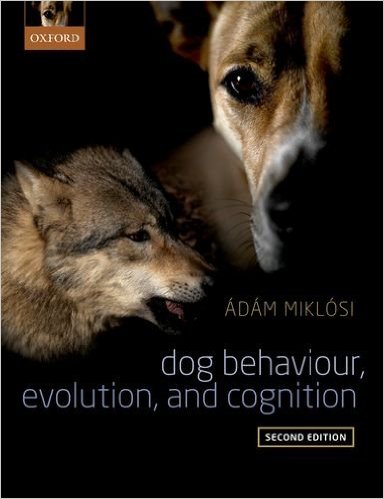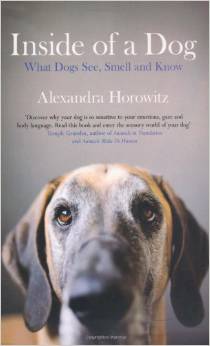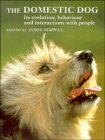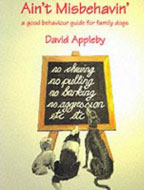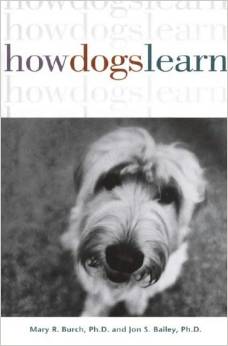Books on Animals: Dogs
Behaviour (canine ethology and behavioural problems)
If you want to buy a book, clicking on the book cover will take you directly to that book on the Amazon.co.uk web site.
See also:

Genius of Dogs: Discovering The Unique Intelligence of Man's Best Friend
The Genius of Dogs is a very useful account of research on canine cognition up to the time the book was published in 2013. It is now a little out of date, but still worth reading for people interested in how dogs think and understand the world. Hare focuses on stories of his initial research with his own dog, and of his later work with domesticated foxes, primitive dogs, and bonobos. He explains how his ideas on domestication and cognition developed. It’s an easy read, and covers a lot of ground, including how domestication changed dogs, and links between breed differences and behaviour. The book doesn’t offer a ‘scientifically proven’ failsafe method for training dogs, what it does do is explain both the exceptional abilities of dogs, and the limits to their understanding, an explanation which is helpful for devising any training plan.
Brian Hare sees the genius of dogs as their special ability to use information from humans, and to co-operate with us. Even puppies have a talent for understanding human gestures, and can learn from observing us. Dogs evolved alongside humans and this continual contact allowed them to develop their ability to understand us, and to persuade us to solve problems for them. Part One of the book focuses on the evolution of dogs, and how domestication improved their ability to understand our communicative gestures. Hare draws parallels between wolves and dogs on the one hand, and chimps and bonobos on the other. He sees dogs and bonobos as better able to co-operate, and less aggressive, and the ability to co-operate as a strength which has helped dogs to survive better than wolves.
Read more: Genius of Dogs: Discovering The Unique Intelligence of Man's Best Friend

Dog behaviour, Evolution and Cognition
Adam Miklosi leads a pioneering team which has been studying dog-human social interactions, using an ethological approach, since 1994. The original head of the research team, Vilmos Csanyi, argues that dogs need social understanding to succeed in the human social world, and that this understanding probably came about as dogs evolved. After Csanyi retired, Miklosi took over leadership of the team. Miklosi´s 'Dog Behaviour,Evolution and Cognition' was published in 2007, and has become a classic. This second edition, first issued as a hardback in 2014, has been updated to cover a large amount of research carried out since 2007. It is, as Miklosi notes, over 40 per cent longer than the first edition!
If you're new to this field, Miklosi's book is best read together with Csanyi's 'If Dogs Could Talk', since they complement one another. Csanyi's book is far more accessible. It's chatty and enthusiastic, and occasionally careless. Miklosi's book is less accessible because it's a serious academic text. One thing I missed, being a non-biologist, was an idiot's guide to biological terms, ie a glossary. So why should a non-biologist bother to read an academic biology book? Not just because Miklosi's team has carried out some ground-breaking research, the second reason is precisely because the book has all the virtues of an academic work. It's thorough, methodical, and carefully written. It also brings together and reviews material from other researchers, in zoology, psychology, genetics, anthrozoology and archaeozoology, as well as ethology, so is a very useful guide to the literature.

The Dog's Mind
Bruce Fogle is a vet, and a prolific writer who is well known for his general guides to dog and puppy care. The Dog's Mind was first published in 1990. It is very accessible. Fogle is good at explaining complex topics like genetics, and how the brain works, in a way that most people can understand. He is very skilled at writing for the general public, and he was an infuential writer in the early 1990s, even in the early 21st century.
The Dog's Mind was a key influence on Cesar Millan. Fogle also influenced Karen Overall's writing, in particular her Clinical Behavioural Medicine for Small Animals (1997, Mosby). Re-reading this book, it is easy to see why. Fogle can negotiate technical topics with ease, he can be funny, lyrical, as when he describes canine play, and even passionate. He obviously likes dogs, so enjoys writing about them. So yes, despite its flaws, this book has much to commend it, both as a good read, and as an important milestone in writing on dogs.

The Other End of the Leash
Patricia McConnell is an animal behaviorist and zoology professor at the University of Wisconsin Madison, specialising in dog behavioral problems. Here she looks at how dogs see humans and human behavior, as canids seeking to understand primates. She is especially good on ways to use your voice with your dog, and how to play games that will help him behave the way you want. Her views on what makes a good leader are also clearly explained, and she contrasts this with old-fashioned ideas on 'dominating' dogs.
O'Connell is well-known for her work on nervous dogs, and her work is generally well-liked by trainers. She writes clearly, constructs arguments well, and bases her arguments on research and observation. Her passion for dogs also comes across clearly - this book has academic strengths without being dry, and there are plenty of anecdotes to keep you amused and interested.

Handbook of Applied Dog Behavior and Training: Procedures and Protocols v. 3
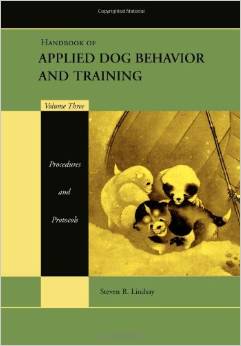
Click on the cover above to go to this book at Amazon.co.uk
Steven Lindsay's Applied Dog Behaviour and Training is an extremely useful resource. It is in three volumes, and pricey. The third volume is the most relevant for tackling problems, because it is the one with solutions, but all three volumes are well worth reading. The first two set you up for understanding the third volume, and give you a wealth of information on how dogs learn, and what may cause behavioural problems.
Lindsay can be a little idiosyncratic, and sometimes takes a long time to explain something simple, but he is very thorough, and has dog-sense. He is American, but like Britain's late John Fisher, has a grounding in dog training as well as a passion for understanding dog behaviour.
Read more: Handbook of Applied Dog Behavior and Training: Procedures and Protocols v. 3

If Dogs Could Talk: Exploring the Canine Mind
In the scientific community, there are two types of knowledge concerning dog research: things we have proven through rigorous experiments, and stuff we "just know".
As a fairly recent addition to the field of dog research, I have witnessed firsthand the stark contrast between what is written up in a scholarly journal article and what is spoken behind closed doors. Vilmos Csanyi’s If Dogs Could Talk elegantly combines the two kinds of knowledge that we have about these beloved animals.
In this book, Csanyi takes great care to inform the reader about the scientifically-proven information we have gained about dogs, and is diligent in drawing a line between scientific studies and anecdotes, while also noting that, taken together, large numbers of anecdotal observations can sometimes eventually become accepted in the body of scientific knowledge. After all, his own field of expertise, ethology, is essentially the observations of animals in their natural habitat until conclusions can be formed about various behaviours of the animal.

In Defence of Dogs
John Bradshaw is a biologist who heads the Anthrozoology Institute at Bristol University. His 'In Defence of Dogs' (called 'Dog Sense' in the US) has become a best-seller, partly because it presents some interesting research in a way that's easy to read.;
The book certainly has some strengths, for example an account of feral dogs in West Bengal, where dogs show pack-like behaviour, with males sometimes helping to feed their young (p73). Bradshaw contrasts this with the less pack-like behaviour of feral dogs in Italy. So, while he argues that dogs are not pack animals in the way wolves are, he does recognise that environment plays a part in how canids organize their lives.

Inside of a Dog: What Dogs See, Smell, and Know: What Dogs Think and Know
Inside of a Dog is a book written by an ethologist and dog cognition researcher, but her book is highly readable. Although it delves into the latest science behind our understanding of the dog’s umwelt, she really takes care to explain what umwelt actually means*, and writes in a way that is easily digested by any interested lay reader.
This book will give you a brief run-down of science’s rapidly evolving insights into dog behaviour, interspersed with short anecdotes about her lifewith Pumpernickel, her dog. Some of these are humorous, and others are poignant, but all give the reader a sense of the importance she placed on her relationship with Pump. Horowitz also gives small snippets of advice along the way, to help the reader understand what their dog really wants. All of these things together create a book that is fun to read and gives the reader a clear idea of how differently humans and dogs perceive their world.
Read more: Inside of a Dog: What Dogs See, Smell, and Know: What Dogs Think and Know

Man Meets Dog
Konrad Lorenz was a Nobel prizewinner who has had a major influence on the study of animal behaviour, especially in Europe. "Man Meets Dog" is a charming account of his views of dog-human relationships, with anecdotes from his own experiences. It's a very entertaining and readable book, which talks about cats as well as dogs.
The book first came out in 1954, but the questions Lorenz asked are questions that dog owners still ask today, such as how dogs see the world, how far their perceptions and behaviours are hard-wired, what influence breed and evolution have had on dogs, how they adapt to human society, how rewards and punishment affect their behaviour, and how owners can cope with the loss of their dogs.
'Man Meets Dog' is also interesting as social history, an account of how people lived with dogs at a time when they were allowed more freedom. This classic is a must read for anyone with an interest in dog behaviour.

The Domestic Dog
This is a collection of articles by different authors on a range of dog topics such as the evolution of dogs from wolves, and how dog breeds developed. There is a lot on the relationship between dogs and humans that can help you to understand your dog, and how what you do affects his behaviour. There are also discussions of the different breeds, and gender differences. There is interesting material on feral dogs in Italy which sheds light on pack behaviour.
This book is for enthusiasts who want access to findings based on solid research, rather than anecdotes. It is essential reading for would-be dog trainers. It doesn't tell you how to train your dog, but it does give you a lot of information to help you to understand your dog, so be better able to train him or her.

Dogs
This is a fascinating and controversial book, which presents a new view of the evolution of the dog as a species in its own right, as opposed to being an inferior type of wolf. The authors use both their extensive experience as trainers, and draw on biological science to develop their theories. They examine the development of different breed types, such as herding dogs, and guarding dogs, and their suitability as companion animals. They also examine the nature-nurture debate, and how the interaction between the two is important for understanding dog behaviour. It helps to have some understanding of zoology to be able to follow all the arguments in this book, but you can enjoy it without being a specialist. You may not agree with everything the authors say, but this book will certainly give you new insights to help you get the best out of your dog.

Dog Language : An Encyclopedia of Canine Behaviour
This is essential reading for anyone interested in dog behaviour and training. Abrantes helps you to communicate with your own dog, as well giving you insights into how dogs communicate with each other. He is accessible enough for non-specialists, and provides a wealth of information for experienced owners. It's a fascinating read, and is very well illustrated.

Ain't Misbehavin': A Good Behaviour Guide for Family Dogs
David Appleby is well known for his work as a pet behaviour counsellor. He takes a common-sense approach to dog behaviour, which should appeal to most pet owners. Like John Fisher (two of whose books are reviewed below) Appleby stresses that dogs are often seen as behaving badly when they are just doing what dogs like to do, which does not always fit in with what humans want from them!
Appleby and Fisher both stress that it helps to understand dogs' natural behaviour, and to understand how our behaviours and lifestyles might be perceived by dogs, in order to get them to do what we want them to do It's worth reading widely if you find dog behaviour fascinating in itself. Ideas are changing all the time, and there are some areas of disagreement between people working in this field. Dog nuts who are interested in dog behaviour may find that this book presents some ideas with too little discussion. Appeleby has, however, written an extremely useful book for people who just want to know enough of the basics to teach their dogs to be good companions, and this book is an excellent starting point for anyone interested in dog behaviour.

How Dogs Learn
A book for anyone interested in dog training who's prepared to learn some of the science behind the ideas. This would suit animal care students, dog trainers and dog behaviourists. Some ordinary mortals who own dogs may find it a little heavy going, and this isn't really a book to buy children with an interest in training their dog, unless they are keen science students. This book does allow you to gain a clear idea of the logic behind training schedules, but be warned, it demands a lot of its readers.

How to Speak Dog
Stanley Coren is a controversial writer, especially for his views on breeds and intelligence. You may not agree with him, but he is certainly entertaining, and gives food for thought. His 'How to Speak Dog' pushes the debate on canine-human communication one level higher, and will help many owners work out just how much human language their pets can understand. Coren is also good on non-verbal communication, and breed variations, both in terms of how dogs understand one another, and how they understand us. This is an inexpensive book, and well worth reading.

Excel-erated Learning
This is a very useful book for anyone wanting to be a trainer, or who wants to understand the rationale behind training methods based on operant and classical conditioning. You need a certain amount of commitment to read the book to the end, since Pamela Reid takes you through some complex ideas. Reid is, however, much easier to follow than Karen Pryor, if you want a full grasp of operant conditioning, and want to apply your knowledge to dogs. There are many illustrative and thought-provoking examples of operant conditioning in use. It's not a 'how to' book, rather it helps with understanding the theory well enough for you to develop your own exercises. Classical conditioning is also covered, as well as terms such as adaptation, desensitisation, counter-conditioning, generalisation, and reinforcers. There is also a discussion of clicker training, and electronic collars.
This book will help you learn the jargon, though it's no substitute for actually working with dogs! Would-be trainers can make best use of the book if they apprentice themselves to a trainer they respect, never mind if the trainer knows the jargon. Dog training is a craft, and skills, such as reading dogs can take years to develop. Many trainers obtain excellent results while using few technical terms, and the theories and explanations set out in this book make much more sense when you have some practical experience.

Genetics and the Social Behavior of the Dog
This book was first published in 1965, and has also come out under the title ‘Dog Behavior: The Genetic Basis’. Why should we bother reading something that came out so long ago? Mainly because it is the result of a long-term experiment to try to tease out the impact of genetics on behaviour, taking developmental stages into account, and it was so thorough that it is still a key text for anyone interested in dog behaviour. Dog breeders will obviously find this book of particular interest, but trainers and pet dog owners can also learn a lot from it. Breeds do differ in how they behave,for example, how easily they live together and share resources, or solve problems, and Scott and Fuller’s work helps with understanding these differences.
The book covers a lot of ground, including dog-dog relationships, various aspects of dog-human relationships, and the physical development of dogs. This is a must-read for any dog nut who wants to understand breed differences, and is especially useful when supplemented with works from modern ethologists. It’s by no means an easy read, but it’s accessible to the general public, and is well worth the effort.
Latest book reviews
Latest news and research
- Impact of facial conformation on canine health: corneal ulceration
- Prevalence of disorders recorded in dogs attending primary-care veterinary practices in England
- Disease control through fertility control: secondary benefits of animal birth control in Indian street dogs.
- Quantifying sources of environmental contamination with Toxocara spp eggs.
- Clostridium difficile in faeces from healthy dogs and dogs with diarrhea
- Impact of canine overweight and obesity on health-related quality of life
- Effect of a diet enriched with green-lipped mussel on pain behavior and functioning in dogs with clinical osteoarthritis
- Short, unstructured session with a dog reduces anxiety levels in students, and improves their mood
- Research suggests canine companionship helps calm children undergoing cancer treatment
- Dingoes in the dock
Care and behaviour of dogs
- Acknowledgments and further reading
- Aggression
- Appetite Loss
- Attention Seeking
- Barking
- Basic training
- Behavioural problems
- Behavioural problems in dogs
- Being sensible with traffic
- Bitches In Season
- Biting
- Canine Social Cognition, part 1: Dogs are special
- Canine Social Cognition, part 2: Differences between dogs
- Chasing Cars, Bikes, Joggers, Cats etc.
- Choosing a dog
- Coming when called
- Designing and using a dog garden
- Destructiveness
- Do you want your pet dog to have puppies?
- Dogs and diet
- Dogs don’t bite humans
- Dogs: Bringing up your puppy
- Dogs: Helping dogs with sound phobias, and fear of fireworks
- Fighting
- Finding a good training class
- Greeting guests politely
- Jealousy
- Jumping Up
- Learning that some animals are prey, others are not
- Mounting
- Multi-dog households: Enjoying life with more than one dog
- Phobias
- Poo Eating
- Possessiveness
- Recall
- Respecting other dogs in the household
- Respecting passers-by, human and canine
- Separation Anxiety
- Stealing
- There are acceptable and unacceptable places to perform (housetraining)
- Toilet Training
- Travelling safely in cars
- Using Flexileads safely
- Vet Phobias
- Walking nicely on the lead
- Walking On The Lead
- Wolves, Dogs and Humans


